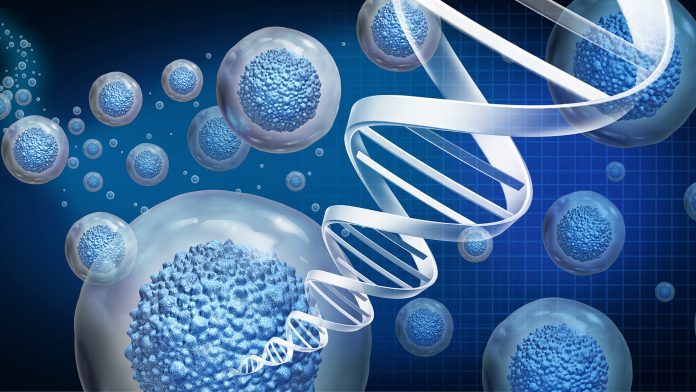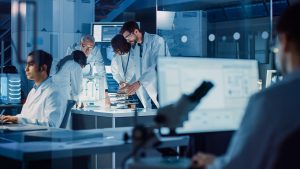
Tissue engineering and organ regeneration expert, Dr Ekaterine Berishvili, discusses the progress, opportunities and challenges of regeneration and repair in organ transplantation.
The growing burden of non-communicable diseases goes hand-in-hand with an increasing need to address tissue defects and organ loss. Organ transplantation is key to improving patient survival and quality of life, as well as relieving a substantial socioeconomic cost. In Europe in 2021, an additional one thousand patients – or nearly five patients per hour – were added to an already enormous waiting list, comprising tens of thousands of patients. While the waiting list was constantly growing, only 36,000 patients received a transplant. It is estimated that of those on the waiting list, up to 4% of patients will die before undergoing a transplantation procedure. This ongoing and widening disparity between supply and demand speaks to the need for organ and tissue sources beyond typical donation avenues. Enter regenerative medicine (RM), an emerging field within biomedical sciences looking to replace, repair or regenerate defective or deficient tissues and organs.
Regenerative medicine
Distinct from traditional transplantation medicine, regenerative medicine (RM) aims to engineer new body parts through a combination of strategies, such as cell therapy, genetic manipulation, immunomodulation and tissue engineering. This latter approach concerns the seeding of biocompatible scaffolds with cells ex vivo for the manufacture of tissues. Perhaps the earliest documented clinical application of tissue engineering, and thus RM, involved the combination of fibroblasts, keratinocytes, and a scaffold to yield a skin replacement intended to promote wound healing.
Over 40 years have passed since these early days of bioengineering and yet, despite the promise of made-to-order lab-grown organs, skin substitutes still perhaps represent the gold standard of commercial tissue-engineered products. Has progress in RM faltered?
The advent of regenerative medicine and current progress
The first commercially available RM product was Integra®, a dermal regeneration scaffold comprising two layers: a silicon-based outer epidermal layer and a collagen-based matrix inner layer. It was first approved by the U.S. Food and Drug Administration in 1996 and pioneered what is today an extensive array of products approved for wound healing and scar treatment, encompassing acellular and cellular platforms based on a variety of biological and synthetic matrices. Some approved indications include skin venous ulcers, diabetic foot ulcers and other chronic wounds.
Cartilage repair is another common application of RM, exploiting relatively straightforward structures lacking robust vasculature, and nervous or lymphatic components – characteristics that inhibit natural healing in vivo yet circumvent significant complications in tissue bioengineering. The use of autologous chondrocytes for cartilage repair was attempted as early as 1994, with the subsequent approval of matrix-assisted autologous chondrocyte implantation in 2001, which led to the launch of similar products indicated for knee defects. These products typically employ collagen-based scaffolds, with some exceptions including Osteopore®, which markets acellular 3D-printed bioresorbable polycaprolactone implants to promote craniofacial bone healing.
Other promising RM therapies are currently undergoing investigation in clinical trials such as Vertex’s VX-880 type 1 diabetes treatment, which uses embryonic stem cell (ESC)-derived functional pancreatic islet cells to restore insulin production. Bioartificial pancreases are also being explored in preclinical studies, such as in the EU-funded VANGUARD project, which aims to assemble insulin-producing organoids and genome-edited cells into a vascularised and functional organ for transplant without the need for lifelong immunosuppression.
However, the only complete human organ to be bioengineered for transplant to date is the bladder, which may be seen as low-hanging fruit for RM – being thin and hollow it is relatively uncomplicated compared with other organs.
Inroads have been made in addressing more complex organs, yet products approved to date are still used for the promotion of healing, rather than the replacement of defective tissues or organs. Holoclar, for instance, was approved by the European Medicines Agency in 2015 for the regeneration of the cornea following burns to the eye. Products for the regeneration of the heart have also been approved, including CardioCel®, an acellular collagen scaffold intended to promote the repair of damaged cardiac tissue by endogenous cells.
Exciting preclinical advances, aided by complementary progress in stem cell technologies and genetic modification, have seen the generation of functional tissues and organs in vitro, commonly through whole-organ decellularisation and recellularisation. The first bioartificial hearts were created from cadaveric rat hearts in 2008 and this success has been reproduced in other tissues and larger, human-sized organs… So where are the bottlenecks in translating these lab-grown organs into routine clinical practice?
Challenges and opportunities
As RM technology has evolved from acellular scaffolds to cellularised materials, the optimal choice of cell source and type has been a key factor to consider. Autologous cell sources provide obvious benefits, removing the need for immunosuppression to prevent the rejection of a new tissue or organ; however, obtaining sufficient quantities of an appropriate tissue remains an issue.
The use of stem cells can bypass this issue because they can be isolated, expanded and differentiated ex vivo into the desired cell type for RM purposes. Pluripotent stem cells are particularly convenient as they have the potential for differentiation into most cell types. ESCs are allogeneic and saddled with ethical concerns; instead, the emergence and refinement of induced pluripotent stem cell (iPSC) technology has provided a near-unlimited autologous stem cell source for tissue engineering applications. While relatively expensive and with lingering safety concerns, ongoing refinement of iPSC manufacturing and differentiation protocols is expected to minimise the impact of these issues.

One of the most significant hurdles in the clinical translation of lab-grown tissues is the difficulty in generating appropriate vasculature
Alternatively, a significant milestone in xenotransplantation was reached in January 2022 when a pig heart, genetically modified to minimise immunogenicity, was successfully transplanted into a live human for the first time. This highlights renewed opportunities in using animals as a potential source of organs (or cells from which to generate bioartificial organs) without immunosuppression, albeit with caveats relating to physiologic discrepancies between species, the potential for infection and ethical concerns around animal welfare and public health.
ECM derived from decellularised animal organs may represent a particularly practical scaffold to be seeded with human cells in the creation of bioartificial organs since it is much more readily available than human organ ECM; however, a multitude of biomaterials have been used to support tissue engineering applications. Biomaterials differ in aspects such as biocompatibility, biodegradability, mechanical properties, porosity, and intrinsic immunogenicity. They may further be impregnated with growth factors and other bioactive molecules to promote growth and healing. Moreover, smart biomaterials currently being developed can change their properties in response to an external stimulus, providing the means to modulate factors such as the differentiation and maturation of cells.
Self-assembling stem-cell-derived 3D organoid cultures have been reported for human tissues. While potentially offering greater physiological and morphological fidelity than bioartificial organs generated from the seeding of acellular scaffolds, organoids are limited in the extent to which they resemble real organs. Growing in a bioreactor, iPSC-derived organoids are deprived a physiological microenvironment and/or sensory input, typically resulting in an immature phenotype, which may inhibit their ability to mature into functional organs in vivo. Headway is being made in controlling maturation using electrical or mechanical stimuli, chemical cues or even exposure to circadian rhythms. In addition, gene editing is being exploited to influence maturation and differentiation, as well as properties of target cells including immunogenicity and capability to secrete therapeutic growth factors.
One of the most significant hurdles in the clinical translation of lab-grown tissues is the difficulty in generating appropriate vasculature. Cells need to be within ~100–200µm of a blood vessel for adequate gas exchange and nutrient delivery; without a proper network of blood vessels, scaling up dense engineered tissues to transplantable organs becomes problematic. Greater control over angiogenesis has been achieved, but they often fail to engage with an endogenous vascular network fast enough upon transplantation, resulting in the death of the tissue.
3D bioprinting has emerged as a potential solution to this issue. Bioprinting can construct complex, heterogenous, functional tissues thanks to the ability to assemble multiple cell types, biomaterials and supporting factors in a directed, layer-by-layer manner. Pre-formed vascular channels may conceivably be printed for rapid integration of engineered tissue with endogenous blood vessels.
A bright future for regenerative medicine
While there has been a significant lag period as biotechnological capabilities caught up with the promise of tissue engineering, the future looks bright. Progress is accelerating as multiple lines of advancement, including stem cell technology, gene editing, bioprinting and industrial fabrication, are being integrated by multidisciplinary teams to realise the promise of RM. As is inevitable when cutting-edge technologies are looking to make an impact in the clinic, regulatory and commercial barriers will also need to be surmounted. Compelling risk–benefit ratios, demonstrable superiority to current alternatives (or otherwise niche applications) and ongoing educational campaigns will be invaluable in ensuring the ultimate clinical adoption of lab-grown organs.
ESOT Congress 2023
I am thrilled to be part of the Executive Group of the Scientific Programme Committee for ESOT Congress 2023, taking place in Athens from 17-20 September. With regeneration and repair playing a major role in this congress, as one of the five congress domains, I am excited about this opportunity for the transplant community to come together with their science and use this to drive advancements in the field. Over the years, the progress achieved in regeneration and repair has been steady but promising. Hopefully, with more great initiatives such as this congress to spark debate and discussion in this area, we can continue to work together to create an extraordinary future for regeneration and repair in organ transplantation.
Dr Ekaterine Berishvili
ESOT Councillor and leader of the Tissue Engineering and Organ Regeneration group in the Department of Surgery
Université de Genève
https://www.unige.ch/medecine/diabetescentre/fr/membres/dr-ekaterine-berishvili/
https://www.linkedin.com/in/ekaterine-berishvili-4102a134/?originalSubdomain=ge
This article is from issue 25 of Health Europa Quarterly. Click here to get your free subscription today.







